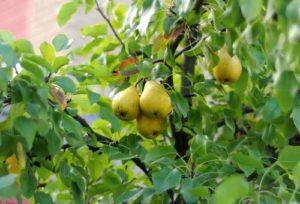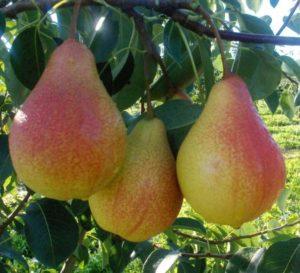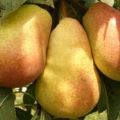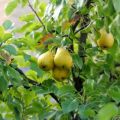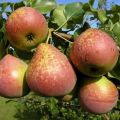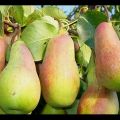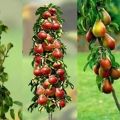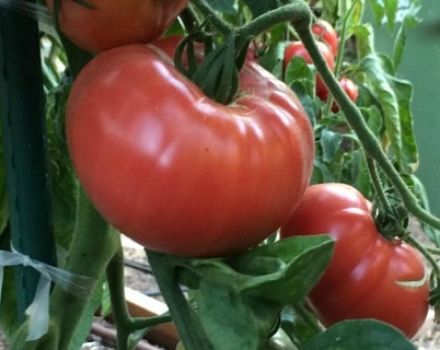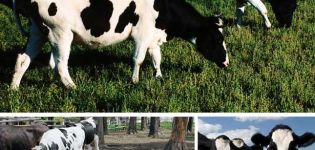Description and characteristics of pear varieties Memory Yakovlev, planting and care
For a long time, pears were grown only in the southern regions, since gardeners believed that the culture felt uncomfortable in a temperate climate. In the 50s of the last century at the Research Institute. Michurin, when crossing the Tema variety and the French Olivier de Serre, a pear was obtained, which inherited excellent yield, frost resistance, and scab immunity from its closest relatives. The compact tree is developing rapidly, it pleases with fruits every year. Pear of Memory Yakovlev's name was given in honor of the family, who devoted a lot of time to its creation.
Description and characteristics of the variety
The hybrid, bred at the Institute of Fruit Growing, is adapted to the conditions of middle latitudes, grows in the southern regions, in the Volga-Vyatka, Central region. The compact tree has a rounded crown, rarely reaching 2 meters in height.
Skeletal branches connect to the trunk at right angles. The shoots are covered with a rough grayish bark, the young growths are brown. The fruits of the variety are formed on ringlets. The buds are distinguished by a smooth surface, in spring they bloom very quickly.
The leaves, located on branches with thorns, are an oval, slightly curved plate with jags.
The flowers of the Yakovlev memory pear are collected in brushes, each of which has up to 8 buds. They appear late. Fruits ripen in September, are harvested throughout the month, are held firmly enough on the elongated stalk.
A ripe pear is different:
- smooth and shiny skin;
- orange tan;
- cream pulp;
- high in sugar.

In the juicy fruits of the Pamyati Yakovlev variety, there is no astringency, a slight sourness is felt, they weigh 100-125 g each. Arbutin, which is rich in autumn pears, acts as an antiseptic, has an antimicrobial effect, and prevents the proliferation of cancer cells.
The favorite of many gardeners and summer residents begins to bear fruit from the age of 4, and at 7 more than 2 buckets of pears are removed from the tree, which do not fall off, do not lose their presentation during transportation over a long distance, evaluated by tasters at 4.4 points.The plant withstands short-term frosts up to 38 ° C, has good immunity to fungal diseases.
Advantages and disadvantages of a pear in memory of Yakovlev
The main advantage of the autumn variety is considered resistance to low temperatures, which makes it possible to grow a crop in mid-latitudes.

The advantages of a pear include:
- Small size of the tree.
- Unpretentiousness to care.
- Excellent taste characteristics.
- No need for pollinators.
- Early maturity and high productivity.
The disadvantages of the variety include the presence of thorns on the shoots and stony cells near the core of the fruit. Collecting pears is delayed, they ripen unevenly, they are not stored for a long time. The tree does not tolerate drought well.
Reproduction
The Yakovlev Memory variety can be bred using layering. A strong branch is bent to the ground, a box with soil is placed under it, to which the shoot is pinned and covered with soil. They maintain humidity in the container, insulate for the winter. After 2 years, when the roots appear, the branch is separated from the tree and sent to the ground. Such a pear quickly begins to bear fruit, retains its maternal properties.
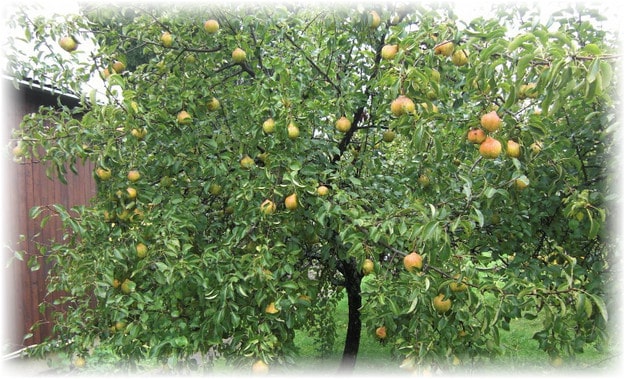
How is the plant planted?
The variety in Memory of Yakovlev can be produced by both the summer resident and the farmer. An unpretentious tree is quickly adopted so that it bears fruit, it is not necessary to place a pollinator nearby.
When planted
Pear grows well in mid-latitudes, but in the Urals and Siberia, it cannot withstand long cold winters. In the regions of the middle zone, the Pamyati Yakovlev variety is planted in the spring, when frosts are no longer expected, in the south this can be done in the fall, but at the beginning, so that the pear has time to start before the temperature drops significantly.
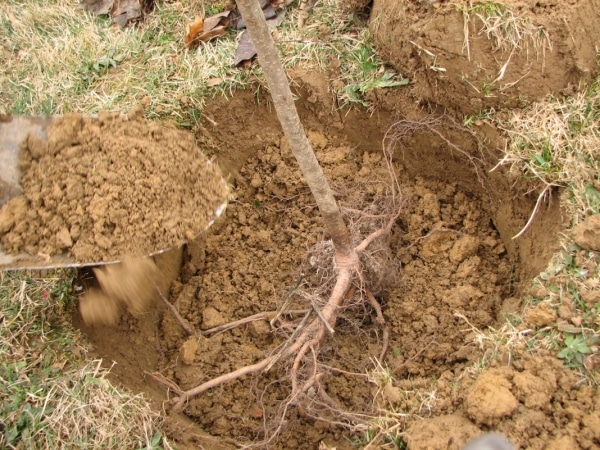
How to choose and prepare seedlings?
You need to buy a tree for growing in a suburban area or in a country house not in the market, but in a nursery, where varieties adapted to the local climate are offered. A pear 2 years old takes root well. It should have elastic roots, shoots without cracks and wounds, fresh wood.
Choosing a landing site
The tree should be placed on a flat surface, not on hills, in an area with direct sunlight. The culture adores loams, black soil; a place where groundwater is located close to the surface is not suitable for its cultivation. To solve the problem in this case, you can use a drainage layer.
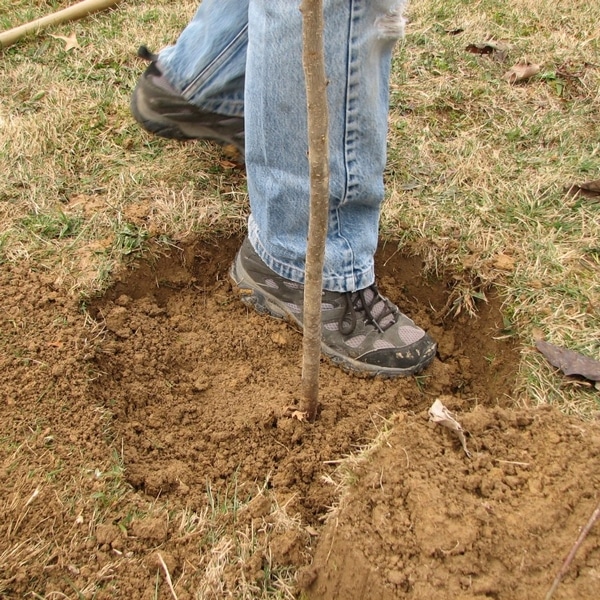
Planting pit preparation
The area for pears in the fall is cleared of the remains of stems and weeds, carefully dug up. The tree of the Pamyati Yakovleva variety has developed roots, which require a lot of space.
A landing pit is made to a depth of at least a meter, with a diameter of 80 to 90 cm.
Pour 2 buckets of sand and humus into the dug hole, add 200 g of superphosphate, 3 tablespoons of potassium salt and mix with earth. Lime or ash is dissolved in 10 liters of water, the composition is poured into a pit. The fertile layer is laid separately.
Distance between seedlings
The Pamyati Yakovlev variety is not very tall, young trees are placed every 3 meters, 4 are left between the rows.
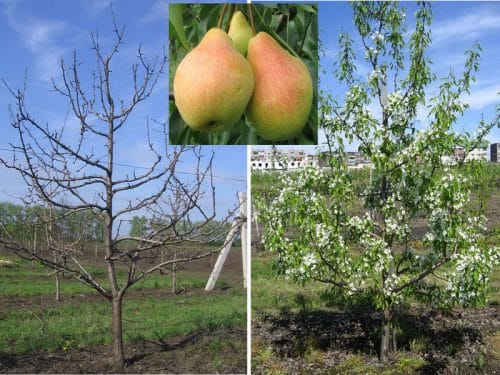
Planting process
7-10 days after the preparation of the pit, soil is poured into it, a mound is formed, on which the root is spread so that the neck is 5 cm above the surface layer. After planting the trees, the soil is compacted, watered with 2 buckets of warm water, the trunk circle is covered with peat. The plant is tied to a peg, which is installed in the center of the pit.
Pollinators
The autumn pear, created by the Yakovlev dynasty, belongs to self-fertile varieties, buds appear on it every year, the ovary does not crumble, fruits ripen. To increase yields, an August pear or Lada is planted nearby. These trees bloom at the same time and serve as a pollinator.

Subtleties of pear care
In order for the variety to please with fruits, before choosing a seedling and a plot, you need to study what the tree needs most, what are the features of caring for the plant.
Watering and feeding
The pear does not tolerate drought well, stops developing, and does not give a good harvest.When waterlogged, the roots rot, which is fraught with the death of the plant. The seedlings are watered every week by letting warm water flow into the grooves dug around the trunk. For one tree you need 2 buckets. If it rains often, adult pears do not require irrigation; in dry weather, moisture is necessary:
- before the appearance of buds;
- with the formation of an ovary;
- late autumn.
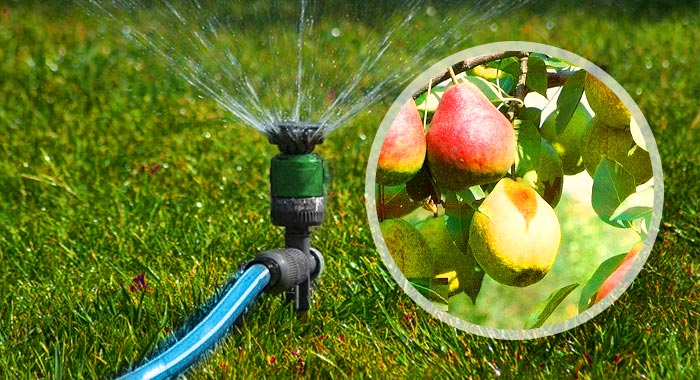
So that water is evenly absorbed into the ground, many summer residents install a sprinkler system. The soil in the trunk circle is loosened, sprinkled with mulch.
2 years after planting in the spring, 80-90 g of urea is dissolved in half a bucket of water, introduced into the ground under a tree, or the granules are simply scattered over the snow.
When the pear fades, they feed it with nitroammophos. To increase yields in summer, potassium salt is used by stirring the product in 10 liters of water. Once every 3 years, while digging up the soil, the soil in the near-trunk circle is fertilized with humus or ash. In order for the tree to overwinter normally, in the fall it is watered with a solution that is prepared from a bucket of water and 30 g of superphosphate. Foliar dressing is carried out in the summer with urea.
Pruning pear
Immediately after planting the trees in the spring, they begin to form the crown. For this, the central shoot is shortened, leaving it at a level of 60 cm from the surface of the site. The next year, strong branches are cut by 1/3, and the stem by 1/4, the rest is removed.
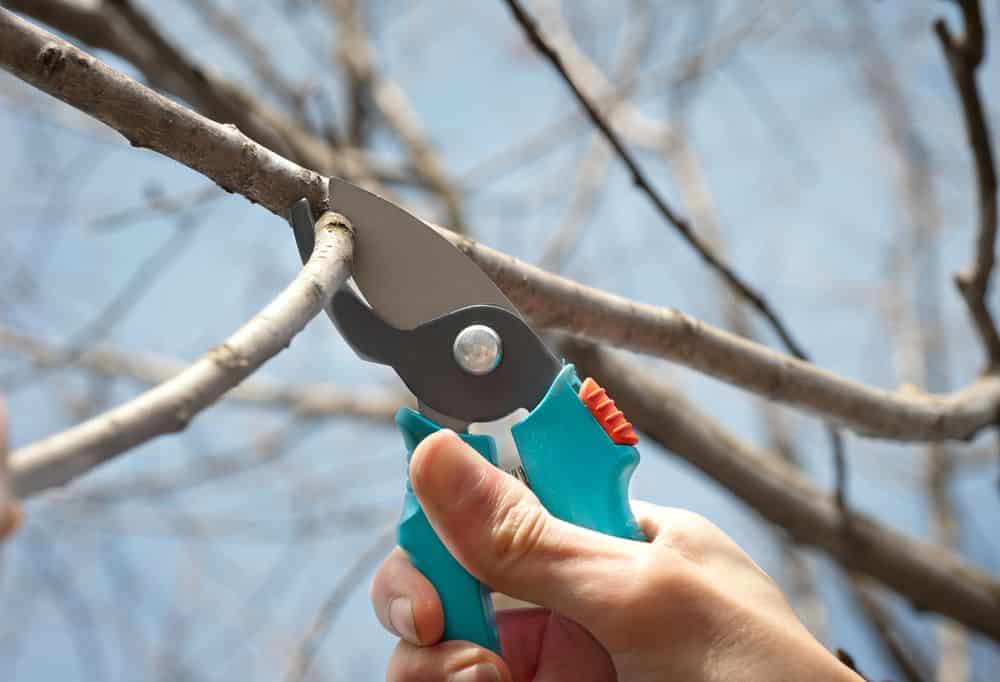
It is constantly necessary to get rid of sick, dried, frozen parts of the tree. In the spring, the crown is freed from shoots that do not bear fruit or grow inward. Regulatory pruning helps improve light and air flow to the pear.
Diseases and pests
Although the variety Pamyati Yakovleva has good immunity to scab, the lack of proper care and prevention, unfavorable weather contribute to the activation of harmful microorganisms.
Diseases that pears are susceptible to
In early spring, fruit trees are sprayed with Bordeaux liquid or vitriol, the trunks are whitewashed with lime, the dried foliage is raked out of the trunk circle and burned. These simple measures help prevent the growth of fungi that cause:
- rust;
- black cancer;
- cytosporosis;
- powdery mildew.
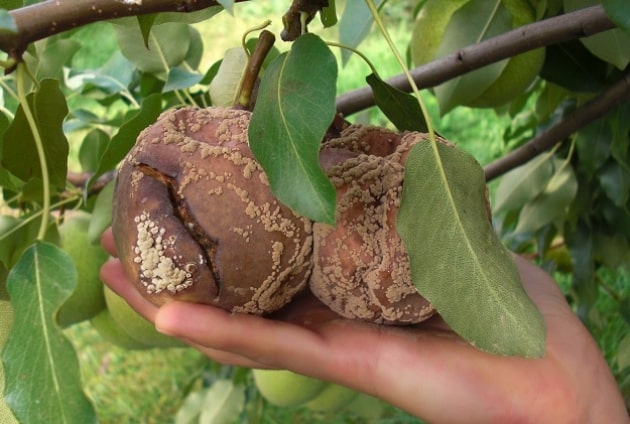
Pears suffer from bacterial and viral infections. It is easier to prevent the development of diseases than to cope with them.
Scab
With dense, thickened plantings, pathogenic fungi let spores into the vegetative organs of the tree. The leaves are covered with dark spots and dry out. The scab affects not only the ovary, but also the fruit. They lose their presentation, the pulp becomes like wood, the skin cracks. The Yakovlev memory variety rarely suffers from this disease.
Moniliosis
A fungal infection, getting into a pear through cracks, wormholes, wounds, provokes the appearance of fruit rot. Damp and warm weather, the presence of scab, thickened crown contributes to the rapid development of moniliosis.

Sooty fungus
Sometimes in summer the leaves of pears are covered with a black bloom. This phenomenon is usually observed when the structure of the plant is damaged by pests, especially aphids.The activation of the soot fungus wintering in the bark leads to a deterioration in photosynthesis and weakens the tree.
Pear pests
Fruit crops suffer not only from diseases, but also from insects. Plants attract flower beetles, silkworms, scale insects, moths, and gall mites.
Aphid
This microscopic parasite feeds on the sap of young branches, has an enviable appetite and multiplies at lightning speed. If you do not immediately engage in the fight against aphids, especially blood, ulcers appear on the shoots of trees, which is fraught with their death.
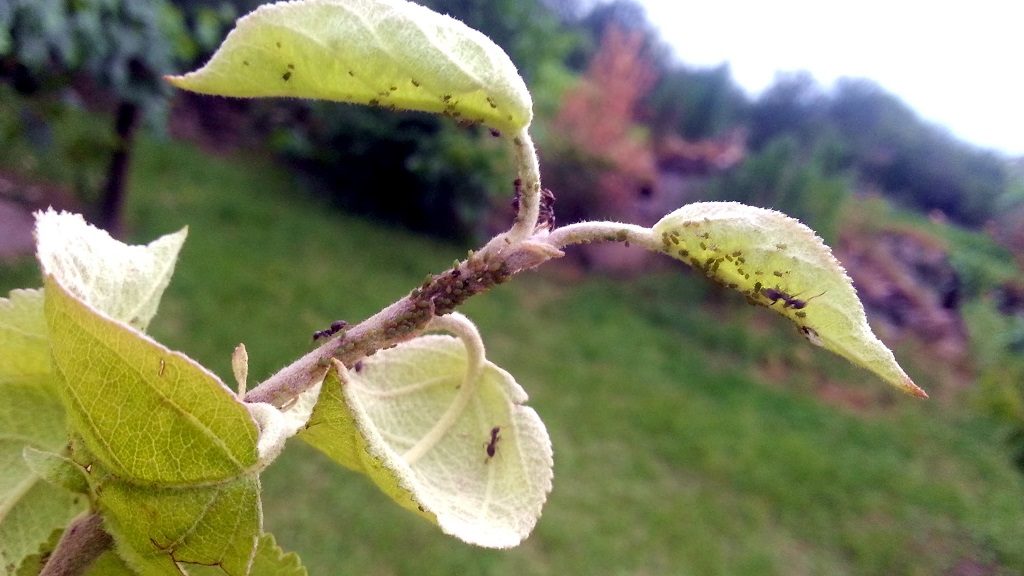
Pear moth
The female moth, the front and rear wings of which are colored in different shades, lays eggs in the seed chamber after mating. To get into it, the pest gnaws holes in the fruit.Having straightened with bones, the caterpillar crawls to the next pear.
The parasite is especially fond of early varieties of the crop, as these fruits have a thin and soft skin.
Pear flower beetle
A pest from the genus of beetles causes huge damage to the crop. The insect gnaws at the cups of fruit buds, which have filled with juice, but did not have time to open, and the tree simply does not bloom, the ovary does not form.
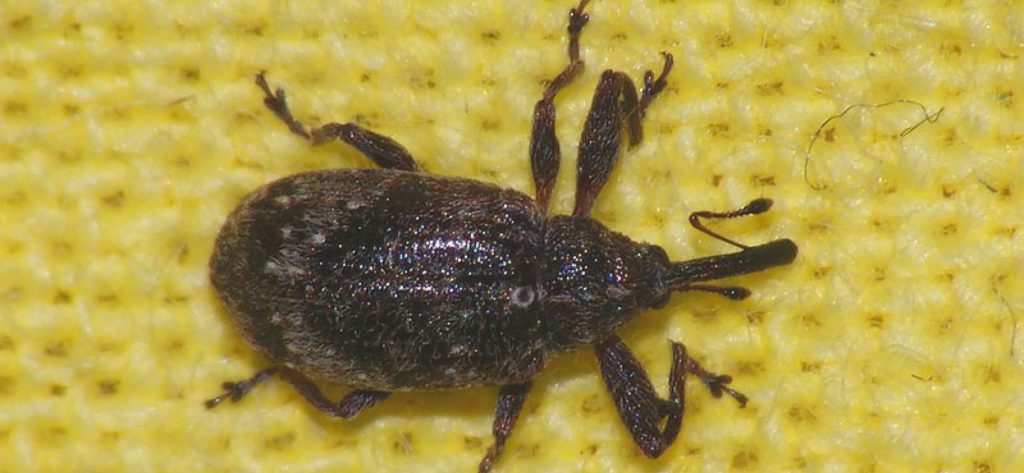
Prevention
To reduce the risk of pear fungal or bacterial infection, all types of pruning are regularly carried out, dried, damaged shoots are removed, and mummified fruits and leaves covered with spots are burned. Several times a season, the trees are fed with nutrients, which helps to strengthen the immune system, and then it is easier for the pear to resist diseases.
To prevent scab, moniliosis and other infections, trees are sprayed with Bordeaux liquid and carbamide, the rules of agricultural technology and care are observed.
Harvesting
The fruits of the Pamyati Yakovlev variety begin to sing from the end of August, but pears are harvested throughout September. Fruits are carefully picked with hands, trying not to get hurt by thorns that are located on the shoots.
Storage
Pears do not fall to the ground, so the entire crop is harvested. In a cool room, the fruits do not deteriorate for a month. They are used to cover compotes, make jams, make juice.
